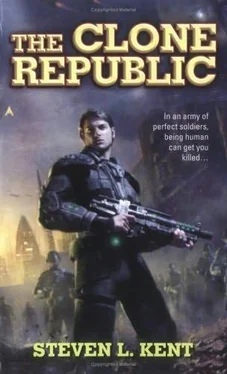Steven Kent - The Clone Republic
Здесь есть возможность читать онлайн «Steven Kent - The Clone Republic» весь текст электронной книги совершенно бесплатно (целиком полную версию без сокращений). В некоторых случаях можно слушать аудио, скачать через торрент в формате fb2 и присутствует краткое содержание. Жанр: Боевая фантастика, на английском языке. Описание произведения, (предисловие) а так же отзывы посетителей доступны на портале библиотеки ЛибКат.
- Название:The Clone Republic
- Автор:
- Жанр:
- Год:неизвестен
- ISBN:нет данных
- Рейтинг книги:5 / 5. Голосов: 1
-
Избранное:Добавить в избранное
- Отзывы:
-
Ваша оценка:
- 100
- 1
- 2
- 3
- 4
- 5
The Clone Republic: краткое содержание, описание и аннотация
Предлагаем к чтению аннотацию, описание, краткое содержание или предисловие (зависит от того, что написал сам автор книги «The Clone Republic»). Если вы не нашли необходимую информацию о книге — напишите в комментариях, мы постараемся отыскать её.
The Clone Republic — читать онлайн бесплатно полную книгу (весь текст) целиком
Ниже представлен текст книги, разбитый по страницам. Система сохранения места последней прочитанной страницы, позволяет с удобством читать онлайн бесплатно книгу «The Clone Republic», без необходимости каждый раз заново искать на чём Вы остановились. Поставьте закладку, и сможете в любой момент перейти на страницу, на которой закончили чтение.
Интервал:
Закладка:
We took flights of stairs between decks because the elevators did not have power yet. The only lighting in one stretch of the ship came from strings of emergency bulbs along the floor. The engineers had not yet installed generators in that area, the seaman told me.
When we finally arrived on the bridge, I saw Klyber standing over two field engineers as they installed components in a weapons station. I read his restlessness in the way he micromanaged these poor engineers, going so far as to complain about the “inefficient” way they laid their tools out.
“Permission to come aboard, sir?” I called from the hatch.
The engineers, who were lying on their backs like mechanics working under a car, watched nervously from beneath the weapons station. Klyber, who stood in his familiar, rigid pose—hands clasped behind his back, legs spread slightly wider than his shoulders—spun to face me. His cold, gray eyes warmed quickly, but he still looked tired.
“Lieutenant Harris,” he said. “Permission granted.”
I saluted.
“That will be all, seaman.” Klyber dismissed the man who had escorted me.
“Perhaps, Lieutenant, you would like a tour of the ship.”
“I would love a tour of the ship, sir,” I said. “I’ve never seen anything like her.”
Klyber smiled, pleased to have his work appreciated. “I am rather excited about her,” he said, sounding both proud and humble.
Having never visited the bridge of a capital ship, I had no point of comparison for the bridge of the Doctrinaire . When completed, the bridge would look more like an office complex than anything else. Rows of desks and computers stretched from wall to wall. I saw nothing even remotely resembling a joystick or a steering wheel.
Klyber led me out of the bridge. “The biggest difficulty in creating a ship of this size is finding a source of power. We needed dual cold-fusion reactors just to power the electrical systems.”
“What about the engines?” I asked.
Klyber laughed. “That is another story entirely. That’s not a function of size, it’s a function of capacity and efficiency. We talked about making engines that were five times larger than the RAMZA engines used on Perseus-class carriers, but they’re too inefficient. We have ended up allocating two-thirds of the ship to carry fuel.”
“Is this a one-ship fleet?” I asked.
“Quite the contrary,” Klyber said as he led me up a flight of stairs. “I will require a massive fleet of support ships to keep this juggernaut rolling.”
We entered a glass-enclosed dome that Klyber identified as the observation deck. The outer skin of the tiny deck was one continuous window. I could see every corner of the ship from there. Engineers and builders in noncombat space suits stood on the scaffolding on the other side of the glass. I watched three men in weighted suits pulling a wagon along the top of the fuselage. Standing on the observation deck, I felt like I could see forever.
“I think I would be scared to come up here during a battle,” I said.
Klyber heard this and smiled. “There’s not a safer spot on this ship. These walls are made out of a plastic polymer. Not even a particle beam can hurt them. And beyond that…” Klyber pointed to two massive rings that encircled the ends of the wings on either side of the wedge-shaped hull. From a distance, the rings would make the Doctrinaire look like she was riding on bicycle tires.
The Kamehameha had shield projector rods—posts that stood no more than twenty feet tall and less than one foot in diameter. The rods projected flat force fields that could filter out large amounts of particle-beam and laser fire. The field fried enemy missiles.
“You have rings instead of rods?” I said. “Will they project your shields in any direction?”
“In every direction,” Klyber said, with the knowing smile of someone who is about to reveal a secret.
“It’s a new technology, Harris; the rings produce a curved shield that stretches all the way around the ship. No Achilles’ heel gaps between shield screens.”
“That is amazing, sir,” I whispered.
Klyber probably did not hear me; he had already started down the stairs. We traveled down eight decks, staying in the center of the ship. The last flight of stairs ended in a glass booth overlooking a dark tunnel that stretched from the stem to the stern.
Hundreds of feet away, I could see balls of sparks where welders worked along the walls and ceiling of the tunnel. I pressed against the window and squinted. Off in the distance, I thought I saw pinpricks of light. “What is this place?” I asked.
“Flight control,” Klyber said. “Each tunnel will have its own squad of fighters.”
“Each tunnel?” I asked.
“There are four tunnels,” Klyber said.
Other fighter carriers used a single flight deck for transports and fighters. This ship had two docking bays and four tunnels. As I considered this, Klyber continued the tour.
I still had not recognized the immense size of the project when Klyber brought me to the high point of his tour. We walked to the bottom deck of the ship and entered the biggest chamber of all.
The area was completely dark as we entered. Klyber tapped a panel beside the door and lights in the ceiling slowly flickered on. Like the tunnels, the chamber stretched the length of the ship. The ceiling was thirty feet high and the floor was at least a hundred feet wide. Every inch of space was filled by an enormous machine surrounded by catwalks riddled with walkways.
“What is this?” I said.
“This is the key to our success, Lieutenant Harris. The Doctrinaire is self-broadcasting. Once we locate the GC Fleet, we will be able to track it, chase it, and ultimately destroy it.”
Admiral Klyber had an agenda. He wanted to bring his two creations together. He wanted to make the galaxy safe for the Unified Authority, and he wanted his Liberator and his supership to lead the charge. In his sixties, Klyber could see retirement approaching, and he wanted to leave a historic legacy.
As for me, I liked serving under Klyber. His paternal feelings toward Liberators gave me access I would never have had under other officers.
I spent one month on the Doctrinaire serving as the chief of security. Everyone in that section of the galaxy had a high security clearance. Except for cargo and parts that were brought in by our own pilots, no ships—friendly or otherwise—came within light-years of our position.
During my tenure as the head of security, I presided over an empty brig. (The only occupants were engineers who drank too much and became disorderly.) I requisitioned supplies. I also nearly forgot what it was like to be a rifleman in the U.A. Marines. Without knowing it, Klyber had domesticated me. I no longer remembered the electric tingle of adrenaline coursing through my veins or endorphins-induced clarity of thought. I was becoming an administrator. Police work did not agree with me; I was made for the battlefield.
Restless as I had become, I began looking for excuses to leave the ship. I accompanied engineers on requisition trips. When new personnel reported for duty, I insisted on briefing them. Klyber warned me that it was risky for me to leave the Doctrinaire . I should have listened to him.
Two new recruits waited for us at the galactic port on Mars. I went to brief the new officers, glad for an excuse to escape from the security station.
I sat in the copilot’s seat of the Johnston R-27 as we self-broadcast from the Doctrinaire to the Norma Arm. From there, we traveled through the broadcast network. It was a new security precaution. Spies and reporters might become curious if they heard about a self-broadcasting ship appearing on Mars radar. Passing through the network only added ten minutes to the trip, though you might have thought it added hours to hear the pilots bitch about it.
Читать дальшеИнтервал:
Закладка:
Похожие книги на «The Clone Republic»
Представляем Вашему вниманию похожие книги на «The Clone Republic» списком для выбора. Мы отобрали схожую по названию и смыслу литературу в надежде предоставить читателям больше вариантов отыскать новые, интересные, ещё непрочитанные произведения.
Обсуждение, отзывы о книге «The Clone Republic» и просто собственные мнения читателей. Оставьте ваши комментарии, напишите, что Вы думаете о произведении, его смысле или главных героях. Укажите что конкретно понравилось, а что нет, и почему Вы так считаете.












